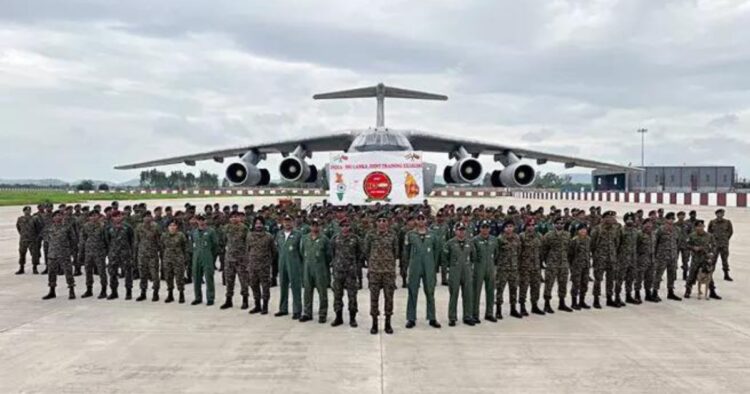The 10th edition of the India-Sri Lanka Joint Military Exercise, known as ‘Mitra Shakti,’ began on August 12 at the Army Training School in Maduru Oya, Sri Lanka. This significant event is set to conclude on August 25. The exercise is an annual training event that alternates between the two countries, and this year, the Indian Army’s K-9 squad is playing a crucial role in the operations.
The Indian contingent participating in ‘Mitra Shakti’ consists of 106 personnel, including a Battalion from the Rajputana Rifles, along with members from other arms and services. On the Sri Lankan side, the Gajaba Regiment of the Sri Lankan Army is representing their nation’s forces.
The purpose of the ‘Mitra Shakti’ exercise is to enhance the joint military capability of both India and Sri Lanka, particularly in counter-insurgency operations within a semi-urban environment. The training is conducted under Chapter VII of the United Nations Mandate, which focuses on maintaining peace and security. This year, the exercise will include various tactical drills, such as responding to terrorist actions, establishing a joint command post, setting up an intelligence and surveillance center, securing landing sites, and conducting special heliborne operations.
One of the key objectives of the exercise is to foster the sharing of best practices between the two armies. By working together, the Indian and Sri Lankan forces can exchange valuable knowledge in Tactics, Techniques, and Procedures for joint operations. This collaboration will help improve interoperability, build camaraderie, and strengthen the bond between the two nations’ military forces.
Impact on India-Sri Lanka Relations
The ‘Mitra Shakti’ exercise is more than just a military drill; it is a symbol of the strong and growing relationship between India and Sri Lanka. By participating in such joint exercises, both countries demonstrate their commitment to regional security and stability.
The training helps the two armies better understand each other’s methods and capabilities, which is essential for effective cooperation in any future joint operations.
For India, the exercise provides an opportunity to showcase its military expertise and reinforce its role as a regional power committed to peace and security. By sharing knowledge and conducting joint operations with Sri Lanka, India strengthens its ties with its southern neighbor, promoting goodwill and mutual respect.
The benefits of the ‘Mitra Shakti’ exercise extend beyond military cooperation. The joint training enhances the overall defense relationship between India and Sri Lanka, contributing to greater trust and understanding between the two nations. This collaboration is crucial in a region where security challenges are ever-present, and both countries stand to gain from their shared efforts to address these challenges.
For Sri Lanka, participating in ‘Mitra Shakti’ allows its military to benefit from India’s vast experience in counter-insurgency operations. This training will help the Sri Lankan forces improve their skills and capabilities, making them better prepared to handle any security threats they may face in the future.
India’s involvement in the ‘Mitra Shakti’ exercise highlights its commitment to fostering strong ties with its neighbors. By engaging in such collaborative efforts, India not only strengthens its defense capabilities but also builds a network of partnerships that contribute to regional peace and stability. The exercise is a clear demonstration of India’s positive role in the region, and its willingness to support its neighbors in building a secure and prosperous future.

















Comments